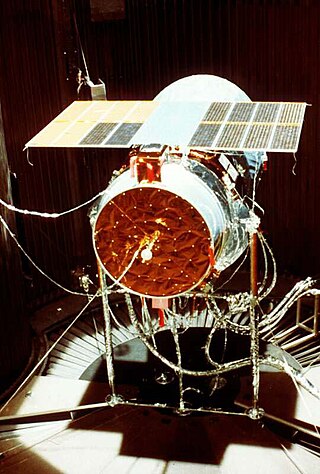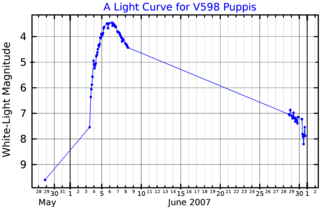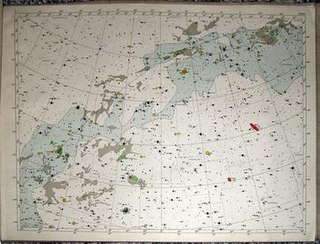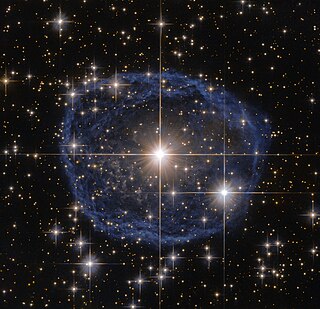
The Infrared Astronomical Satellite (IRAS) was the first space telescope to perform a survey of the entire night sky at infrared wavelengths. Launched on 25 January 1983, its mission lasted ten months. The telescope was a joint project of the United States (NASA), the Netherlands (NIVR), and the United Kingdom (SERC). Over 250,000 infrared sources were observed at 12, 25, 60, and 100 micrometer wavelengths.

Bohdan Paczyński or Bohdan Paczynski was a Polish astronomer notable for his theories and work in the fields of stellar evolution, accretion discs, and gamma ray bursts. He is the recipient of the Eddington Medal (1987), the Henry Draper Medal (1997), the Gold Medal of the Royal Astronomical Society (1999), and the Order of Polonia Restituta (2007).

The Sloan Digital Sky Survey or SDSS is a major multi-spectral imaging and spectroscopic redshift survey using a dedicated 2.5-m wide-angle optical telescope at Apache Point Observatory in New Mexico, United States. The project began in 2000 and was named after the Alfred P. Sloan Foundation, which contributed significant funding.
The National Geographic Society – Palomar Observatory Sky Survey was a major astronomical survey, that took almost 2,000 photographic plates of the night sky. It was conducted at Palomar Observatory, California, United States, and completed by the end of 1958.

La Silla Observatory is an astronomical observatory in Chile with three telescopes built and operated by the European Southern Observatory (ESO). Several other telescopes are also located at the site and are partly maintained by ESO. The observatory is one of the largest in the Southern Hemisphere and was the first in Chile to be used by ESO.

An astronomical survey is a general map or image of a region of the sky that lacks a specific observational target. Alternatively, an astronomical survey may comprise a set of images, spectra, or other observations of objects that share a common type or feature. Surveys are often restricted to one band of the electromagnetic spectrum due to instrumental limitations, although multiwavelength surveys can be made by using multiple detectors, each sensitive to a different bandwidth.

The Panoramic Survey Telescope and Rapid Response System located at Haleakala Observatory, Hawaii, US, consists of astronomical cameras, telescopes and a computing facility that is surveying the sky for moving or variable objects on a continual basis, and also producing accurate astrometry and photometry of already-detected objects. In January 2019 the second Pan-STARRS data release was announced. At 1.6 petabytes, it is the largest volume of astronomical data ever released.

Grzegorz Pojmański, is a Polish astronomer and professor at the Warsaw University Astronomical Observatory, Poland. In 1997 Pojmański together with professor Bohdan Paczyński implemented the project All Sky Automated Survey (ASAS). With the ASAS Alert System Pojmański discovered two new comets: C/2004 R2 (ASAS) and C/2006 A1 (Pojmański). Pojmański connects with the ASAS automatic telescope located in Las Campanas Observatory, Chile, via Internet.

The Optical Gravitational Lensing Experiment (OGLE) is a Polish astronomical project based at the University of Warsaw that runs a long-term variability sky survey (1992–present). The main goals are the detection and classification of variable stars, discovery of microlensing events, dwarf novae, and studies of the structure of the Galaxy and the Magellanic Clouds. Since the project began in 1992, it has discovered a multitude of extrasolar planets, together with the first planet discovered using the transit method (OGLE-TR-56b) and gravitational microlensing. The project has been led by professor Andrzej Udalski since its inception.

Comet Pojmański is a non-periodic comet discovered by Grzegorz Pojmański on January 2, 2006, and formally designated C/2006 A1. Pojmański discovered the comet at Warsaw University Astronomic Observatory using the Las Campanas Observatory in Chile as part of the All Sky Automated Survey (ASAS). Kazimieras Cernis at the Institute of Theoretical Physics and Astronomy at Vilnius, Lithuania, located it the same night and before the announcement of Pojmański's discovery, in ultraviolet images taken a few days earlier by the SWAN instrument aboard the SOHO satellite. A pre-discovery picture was later found from December 29, 2005.

V598 Puppis is the name given to a nova in the Milky Way Galaxy. USNO-A2.0 0450-03360039, a catalog number for the star, was discovered to be much brighter than normal in X-ray emissions on October 9, 2007, by the European Space Agency's XMM-Newton telescope. The star was confirmed to be over 10 magnitudes, or 10,000 times, brighter than normal by the Magellan-Clay telescope Magellan-Clay telescope at Las Campanas Observatory in Chile. Pre-discovery images and identification of the progenitor would ultimately shows that the nova brightened from visual magnitude 16.6 to brighter than magnitude 4.

The Skalnaté Pleso Atlas of the Heavens is a set of 16 celestial charts covering the entire sky. It is named after the Skalnaté Pleso Observatory in Slovakia where it was produced. The first versions were published by the Czechoslovak Astronomical Society in 1948; later that year, Sky Publishing Corporation acquired the copyright and began publication in the United States. The charts were hand-drawn by Antonín Bečvář.

HD 160529 is a luminous blue variable (LBV) star located in the constellation of Scorpius. With an apparent magnitude of around +6.8 cannot be seen with the naked eye except under very favourable conditions, but it is easy to see with binoculars or amateur telescopes.

Time-domain astronomy is the study of how astronomical objects change with time. Said to have begun with Galileo's Letters on Sunspots, the field has now naturally expanded to encompass variable objects beyond the Solar System. Temporal variation may originate from movement of the source or changes in the object itself. Common targets include novae, supernovae, pulsating stars, flare stars, blazars and active galactic nuclei. Optical time domain surveys include OGLE, HAT-South, PanSTARRS, SkyMapper, ASAS, WASP, CRTS, GOTO, and the forthcoming LSST at the Vera C. Rubin Observatory.
IRC −10414 is a red supergiant and runaway star in the constellation Scutum, a rare case of a red supergiant with a bow shock.
The All Sky Automated Survey for SuperNovae (ASAS-SN) is an automated program to search for new supernovae and other astronomical transients, headed by astronomers from the Ohio State University, including Christopher Kochanek and Krzysztof Stanek. It has 20 robotic telescopes in both the northern and southern hemispheres. It can survey the entire sky approximately once every day.

WR 31a, commonly referred to as Hen 3-519, is a Wolf–Rayet (WR) star in the southern constellation of Carina that is surrounded by an expanding Wolf–Rayet nebula. It is not a classical old stripped-envelope WR star, but a young massive star which still has some hydrogen left in its atmosphere.

C/2017 O1 (ASASSN) is a comet discovered by the All Sky Automated Survey for SuperNovae (ASAS-SN). It was first detected on July 19, 2017, located in the southern constellation Cetus.

The Astronomical Observatory University of Warsaw is an institute that conducts astronomical research and teaching in astronomy. It is a part of Faculty of Physics University of Warsaw. The Observatory provides astronomy classes for BSc, MSc, and PhD students. Student telescope activities take place at the observing station in Ostrowik. The scientific research is conducted in a wide range of topics. Two main observing projects are long-term sky surveys: OGLE and ASAS. Both surveys take data using dedicated telescopes located at the Las Campanas Observatory, Chile. Scientific staff takes part in large astrophysical collaborations, both ground-based and satellite.

















